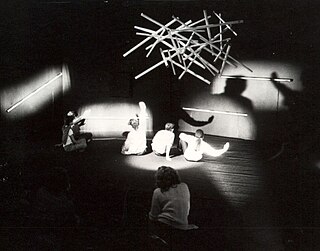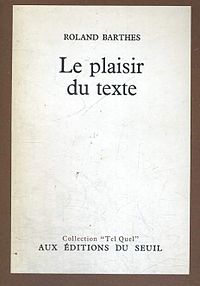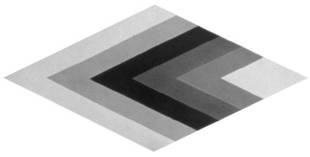Related Research Articles

Interactive art is a form of art that involves the spectator in a way that allows the art to achieve its purpose. Some interactive art installations achieve this by letting the observer or visitor "walk" in, on, and around them; some others ask the artist or the spectators to become part of the artwork.
Postdigital, in artistic practice, is an attitude that is more concerned with being human, than with being digital, similar to the concept of "undigital" introduced in 1995, where technology and society advances beyond digital limitations to achieve a totally fluid multimediated reality that is free from artefacts of digital computation.

The Pleasure of the Text is a 1973 book by the literary theorist Roland Barthes.
Information art, which is also known as informatism or data art, is an emerging art form that is inspired by and principally incorporates data, computer science, information technology, artificial intelligence, and related data-driven fields. The information revolution has resulted in over-abundant data that are critical in a wide range of areas, from the Internet to healthcare systems. Related to conceptual art, electronic art and new media art, informatism considers this new technological, economical, and cultural paradigm shift, such that artworks may provide social commentaries, synthesize multiple disciplines, and develop new aesthetics. Realization of information art often take, although not necessarily, interdisciplinary and multidisciplinary approaches incorporating visual, audio, data analysis, performance, and others. Furthermore, physical and virtual installations involving informatism often provide human-computer interaction that generate artistic contents based on the processing of large amounts of data.
Roy Ascott FRSA is a British artist, who works with cybernetics and telematics on an art he calls technoetic by focusing on the impact of digital and telecommunications networks on consciousness. Since the 1960s, Ascott has been a practitioner of interactive computer art, electronic art, cybernetic art and telematic art.

The Planetary Collegium is an international transcultural and transdisciplinary new media art educational research platform that promotes on the doctorate level the integration of art, science, technology, and consciousness research under the rubric of the technoetic arts. It is based in the School of Art, Design and Architecture department at Plymouth University in the United Kingdom with nodes in Trento, Lucerne and Shanghai. Since its inception in 1994, over 80 doctoral candidates have graduated from the Planetary Collegium with Plymouth University PhDs. The founding President is Professor Roy Ascott.
Sharon Grace is an American artist, currently a Professor Emeritus at the San Francisco Art Institute, who is known for initiating the use of many forms of electronic media based in audiovisual technology. Since 1970, Grace has worked with telecommunications as art, embedding interactive video and speech recognition in her work including video installation, electronic synthesis, interactive digital systems, and sculpture in stone and steel.
Telematic art is a descriptive of art projects using computer-mediated telecommunications networks as their medium. Telematic art challenges the traditional relationship between active viewing subjects and passive art objects by creating interactive, behavioural contexts for remote aesthetic encounters. Telematics was first coined by Simon Nora and Alain Minc in The Computerization of Society. Roy Ascott sees the telematic art form as the transformation of the viewer into an active participator of creating the artwork which remains in process throughout its duration. Ascott has been at the forefront of the theory and practice of telematic art since 1978 when he went online for the first time, organizing different collaborative online projects.

Francesco Monico is a teacher, researcher, artist in Italy.

Systems art is art influenced by cybernetics, and systems theory, that reflects on natural systems, social systems and social signs of the art world itself.

Edward A. Shanken is an American art historian, whose work focuses on the entwinement of art, science and technology, with a focus on experimental new media art and visual culture. Shanken is an associate professor of digital art & new media at UC Santa Cruz. His scholarship has appeared in numerous journals and anthologies and has been translated into many languages. Shanken is the author of Art and Electronic Media, among other titles.

Cybernetics is a wide-ranging field concerned with regulatory and purposive systems. The core concept of cybernetics is circular causality or feedback—where the observed outcomes of actions are taken as inputs for further action in ways that support the pursuit and maintenance of particular conditions, or their disruption. Cybernetics is named after an example of circular causality, that of steering a ship, where the helmsperson maintains a steady course in a changing environment by adjusting their steering in continual response to the effect it is observed as having. Other examples of circular causal feedback include: technological devices such as thermostats ; biological examples such as the coordination of volitional movement through the nervous system; and processes of social interaction such as conversation. Cybernetics is concerned with feedback processes such as steering however they are embodied, including in ecological, technological, biological, cognitive, and social systems, and in the context of practical activities such as designing, learning, managing, conversation, and the practice of cybernetics itself. Cybernetics' transdisciplinary and "antidisciplinary" character has meant that it intersects with a number of other fields, leading to it having both wide influence and diverse interpretations.

Hybrid art is a contemporary art movement in which artists work with frontier areas of science and emerging technologies. Artists work with fields such as biology, robotics, physical sciences, experimental interface technologies, artificial intelligence, and information visualization. They address the research in many ways such as undertaking new research agendas, visualizing results in new ways, or critiquing the social implications of the research. The worldwide community has developed new kinds of art festivals, information sources, organizations, and university programs to explore these new arts.

Internet art is a form of new media art distributed via the Internet. This form of art circumvents the traditional dominance of the physical gallery and museum system. In many cases, the viewer is drawn into some kind of interaction with the work of art. Artists working in this manner are sometimes referred to as net artists.
Robert Adrian (1935–2015), also known as Robert Adrian X, was a Canadian artist who made radio and telecommunications art. Adrian moved from Canada to Vienna, Austria in 1972 where he became known for creating experimental artworks using radio and communications technologies. His work The World in 24 Hours, which connected artists in different cities and continents through telephone lines and radio, is considered to be one of the first experiments in online culture. Adrian is considered to be a pioneer in the field of telecommunications art and media art.

New media art includes artworks designed and produced by means of electronic media technologies, comprising virtual art, computer graphics, computer animation, digital art, interactive art, sound art, Internet art, video games, robotics, 3D printing, and cyborg art. The term defines itself by the thereby created artwork, which differentiates itself from that deriving from conventional visual arts. New Media art has origins in the worlds of science, art, and performance. Some common themes found in new media art include databases, political and social activism, Afrofuturism, feminism, and identity, a ubiquitous theme found throughout is the incorporation of new technology into the work. The emphasis on medium is a defining feature of much contemporary art and many art schools and major universities now offer majors in "New Genres" or "New Media" and a growing number of graduate programs have emerged internationally. New media art may involve degrees of interaction between artwork and observer or between the artist and the public, as is the case in performance art. Yet, as several theorists and curators have noted, such forms of interaction, social exchange, participation, and transformation do not distinguish new media art but rather serve as a common ground that has parallels in other strands of contemporary art practice. Such insights emphasize the forms of cultural practice that arise concurrently with emerging technological platforms, and question the focus on technological media per se. New Media art involves complex curation and preservation practices that make collecting, installing, and exhibiting the works harder than most other mediums. Many cultural centers and museums have been established to cater to the advanced needs of new media art.
Cybernetic art is contemporary art that builds upon the legacy of cybernetics, where feedback involved in the work takes precedence over traditional aesthetic and material concerns. The relationship between cybernetics and art can be summarised in three ways: cybernetics can be used to study art, to create works of art or may itself be regarded as an art form in its own right.

Sherrie Rabinowitz (1950–2013) was an American video artist and a pioneer in satellite-based telecommunications art. She worked exclusively with Kit Galloway under the moniker Mobile Image from 1977 onwards. She co-founded the Electronic Café International (ECI), a performance space and real café housed in the 18th Street Arts Center in Santa Monica, California, with Galloway. She died in 2013, from complications due to multiple sclerosis.
Media art history is an interdisciplinary field of research that explores the current developments as well as the history and genealogy of new media art, digital art, and electronic art. On the one hand, media art histories addresses the contemporary interplay of art, technology, and science. On the other, it aims to reveal the historical relationships and aspects of the ‘afterlife’ in new media art by means of a historical comparative approach. This strand of research encompasses questions of the history of media and perception, of so-called archetypes, as well as those of iconography and the history of ideas. Moreover, one of the main agendas of media art histories is to point out the role of digital technologies for contemporary, post-industrial societies and to counteract the marginalization of according art practices and art objects: ″Digital technology has fundamentally changed the way art is made. Over the last forty years, media art has become a significant part of our networked information society. Although there are well-attended international festivals, collaborative research projects, exhibitions and database documentation resources, media art research is still marginal in universities, museums and archives. It remains largely under-resourced in our core cultural institutions.″
A vidéothèque is a virtual or physical library of videos. The concept originated as installations in museums or art galleries, but has been extended to video libraries on websites and physical fixed libraries and mobile libraries. Noted examples include those at ARTCENA, fr:Centre national du théâtre, Paris, Minpaku, Osaka and Ars Electronica in Linz
References
- Ascott, R. (2003). Quando an onça se deita com a ovelha: a arte com mídias úmidas e a cultura pós-biológica. In: DOMINGUES, D. (ed). Arte e vida no século XXI. São Paulo: Editora UNESP. pp. 273–284
- Ascott, R. (2003). Telematic Embrace: visionary theories of art, technology and consciousness. (Edward A. Shanken, ed.) Berkeley: University of California Press, pp. 6, 376, 378, 380-381
- Monico, F. (2008). La Variazione Technoetica in "Le variazioni Grandi" Quaderno di Comunicazione 8. Roma: Meltemi.